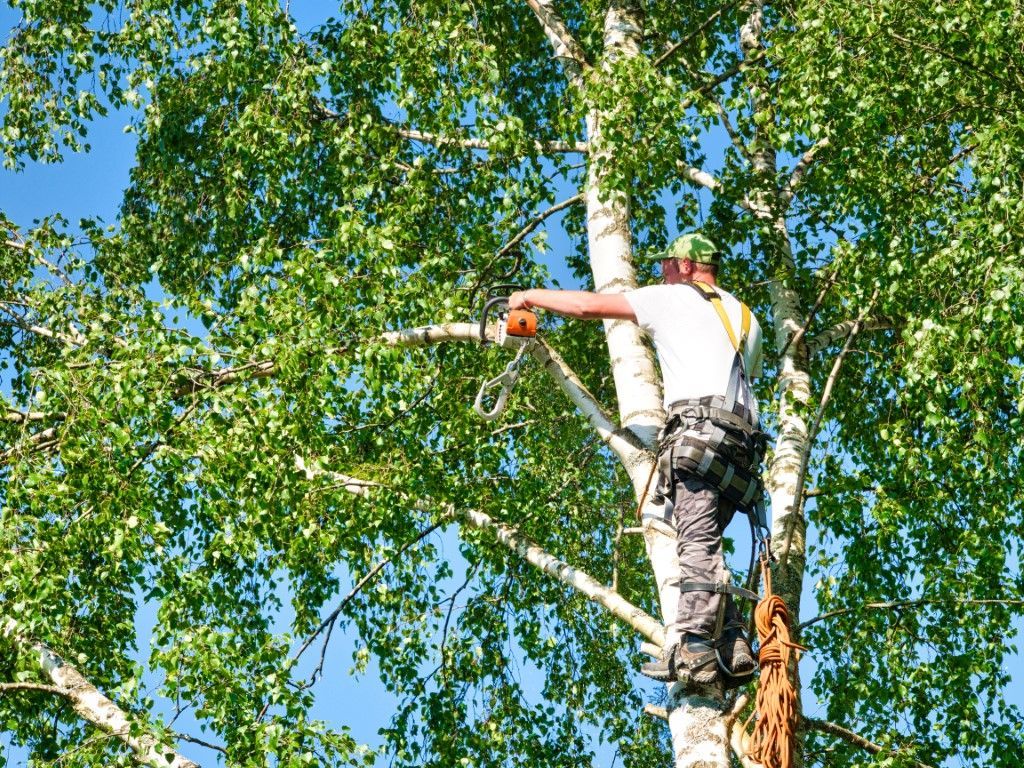
Riverton Tree Service
Happiness of Client And Quality Service,
Always Our Priority
Tree Trimming in Riverton UT
Tree trimming is the practice of cutting back parts of a tree to maintain its health, shape, and safety. This process involves removing certain branches, shoots, or stems to encourage proper growth and to ensure that the tree remains strong and visually appealing. Proper tree trimming can help trees grow more vigorously and can also improve the overall aesthetics of your landscape.
Types of Tree Trimming
There are several methods of tree trimming, each serving different purposes.
- Canopy Thinning involves removing a portion of the inner branches to allow more light to penetrate through the canopy and to reduce wind resistance. This technique helps in maintaining the overall health of the tree by improving air circulation and sunlight exposure.
- Crown Reduction is used to reduce the size of the tree's crown while preserving its natural shape. This method is often employed to manage the tree's height or spread and to keep it away from power lines or structures.
- Deadwood Removal focuses on cutting away dead or dying branches that can pose a safety hazard or lead to decay. This technique helps in preventing the spread of diseases and pests.
- Elevating involves removing lower branches to provide clearance for pedestrians, vehicles, or buildings. This can be particularly useful for trees that have grown too close to walkways or roadways.

FREE 100% INSTANT QUOTE!
FREE 100% INSTANT QUOTE!
Thank you for contacting Riverton Tree Services.
We will get back to you as soon as possible.
Please try again later.
Why Tree Trimming is Essential
Tree trimming is crucial for several reasons. First, it promotes healthy growth by removing dead or diseased branches, which helps the tree allocate nutrients more effectively. Second, it enhances the safety of your property by reducing the risk of falling branches that could cause damage or injury. Third, it can improve the appearance of your trees, making your outdoor space more attractive. Lastly, regular trimming can prevent potential issues with tree diseases and pests by keeping the tree in a balanced and healthy state.
Tools and Equipment
Effective tree trimming requires the right tools and equipment. Some of the essential tools include:
- Pruning Shears for cutting small branches and twigs.
- Loppers for reaching higher branches that are too thick for shears.
- Saw for larger branches that cannot be cut with shears or loppers.
- Pole Pruners for trimming branches that are out of reach without a ladder.
- Safety Gear including gloves, goggles, and helmets to protect yourself while working.
When to Trim Trees
The timing of tree trimming can impact the health and growth of the tree. Generally, it is best to trim trees during their dormant season, which is typically in late winter or early spring before new growth begins. However, specific timing can vary depending on the type of tree and local climate conditions. Avoid trimming during periods of heavy rain or extreme temperatures, as these conditions can make the process more difficult and could potentially harm the tree.
DIY vs. Professional Tree Trimming
While some people choose to trim their trees themselves, professional tree trimming offers several advantages. Experienced arborists have the knowledge and expertise to perform the job safely and effectively. They can assess the health of your trees, select the appropriate trimming methods, and handle any potential hazards. On the other hand, DIY trimming may seem cost-effective but can be risky, especially if you're unfamiliar with the proper techniques or if you lack the necessary tools and safety equipment.
Scheduling Regular Trims and Inspections
Regular tree trimming and inspections are essential for maintaining the health and appearance of your trees. Scheduling annual or biannual trims can help ensure that your trees remain in good shape and can prevent problems before they become serious. Additionally, regular inspections by a professional can identify potential issues early, such as diseases or structural weaknesses, allowing for timely intervention.
If you're looking for expert
tree trimming services in Riverton, UT, we're here to help. Our team of skilled professionals can provide top-quality care for your trees, ensuring they remain healthy and beautiful. Contact us today to schedule an appointment or to learn more about how we can assist you with all your tree care needs.
The Impact of Tree Trimming on Tree Health and Growth
Tree trimming is more than just a routine maintenance task; it's a crucial aspect of ensuring the health and vitality of trees. Whether in residential yards or public parks, well-maintained trees contribute significantly to the beauty and ecological balance of their surroundings. Tree trimming, also known as pruning, involves selectively removing specific branches or stems to improve a tree's structure and function. This practice is essential for several reasons, each contributing to the overall health and growth of the tree.

Enhancing Air Circulation and Sunlight Penetration
One of the primary benefits of tree trimming is the improvement of air circulation and sunlight penetration through the canopy. By removing excess or overcrowded branches, trimmed trees allow more light to reach the inner parts of the canopy and the ground beneath. This increased sunlight can help the tree's lower branches thrive and promotes healthier foliage. Improved air circulation also reduces the risk of fungal infections and diseases that thrive in stagnant, humid conditions.
Preventing Disease and Pest Infestation
Regular trimming helps in the prevention of diseases and pest infestations. Removing dead, diseased, or damaged branches helps to stop the spread of diseases that can potentially harm the tree. Pests often find shelter in overgrown and neglected branches, so trimming helps reduce the risk of pest infestations. By keeping the tree well-maintained, you can minimize the need for more aggressive treatments or interventions later on.
Promoting Stronger Structure
Tree trimming helps in shaping and strengthening a tree's structure. Removing weak or competing branches encourages the tree to develop a strong central leader and a balanced canopy. This structural enhancement is particularly important for young trees, as it helps them grow into mature trees with sturdy branches that can withstand storms and other environmental stresses.
Encouraging Healthy Growth
When done correctly, tree trimming can stimulate new growth. By cutting back on older or less productive branches, the tree can redirect its energy to new, healthy growth. This process, known as "thinning," allows the tree to focus its resources on developing robust new shoots and leaves. Additionally, regular trimming can help shape the tree to better fit its environment, preventing it from becoming too large or unwieldy.
Improving Aesthetic Appeal
Beyond health benefits, tree trimming also enhances the visual appeal of trees. A well-trimmed tree looks more attractive and can complement the overall landscape design. Removing unsightly branches and ensuring a well-balanced canopy can make a significant difference in the appearance of your trees, adding to the beauty and value of your property.
Maintaining the health and beauty of your trees requires expertise and care. If you're looking for professional tree trimming services, don’t hesitate to reach out to us. Our team of skilled arborists is dedicated to providing high-quality tree care to ensure your trees remain healthy, vibrant, and aesthetically pleasing. Contact us today to schedule a consultation and take the first step toward enhancing the health and growth of your trees.
Seasonal Tree Trimming: Best Practices Throughout the Year
Trees are not just a beautiful addition to any landscape; they also play a crucial role in enhancing the environment and providing shade and shelter. Proper tree care is essential for maintaining their health and beauty. One key aspect of tree care is seasonal trimming. By understanding and implementing the best practices for trimming throughout the year, you can ensure that your trees remain healthy, vibrant, and well-maintained.
Winter Trimming
Winter is a good time for tree trimming, particularly when the trees are dormant. During this period, it's easier to see the structure of the tree without the distraction of leaves. Winter trimming can help in several ways. First, it reduces the risk of disease and pests that can thrive in the warmer months. Second, it encourages strong growth in the spring. However, avoid trimming during extreme cold spells, as this can harm the tree. Ensure that the tools are sharp and clean to prevent damage and disease.
Spring Trimming
Spring is a period of active growth for most trees, making it an important time to focus on trimming. However, the approach to spring trimming should be different from winter. Focus on removing any dead or diseased branches. This helps the tree allocate resources to healthy growth. Be cautious with heavy pruning, as it can stress the tree and impact its growth. Additionally, avoid trimming during the early part of the season when the tree is just beginning to bud, as this can interfere with the natural growth cycle.
Summer Trimming
Summer trimming can be beneficial, particularly for trees that have grown excessively or have dense canopies. During this season, it's important to manage the tree’s shape and ensure that it does not become too overcrowded. This helps improve air circulation and sunlight penetration, which can reduce the risk of disease. Be mindful not to remove too much foliage, as this can stress the tree and affect its ability to photosynthesize. Summer trimming should be light and focused on shaping and removing problematic branches.
Fall Trimming
Fall is another good time for tree trimming, particularly for preparing trees for the coming winter. This is a great time to address any issues that have developed over the growing season. Removing weak or damaged branches can help prevent breakage during winter storms. However, avoid trimming too late in the fall as this can expose the tree to potential winter damage. Ensure that the trimming is completed before the first frost to allow the tree to begin healing before the cold weather sets in.
Overall Best Practices
Regardless of the season, there are some best practices to follow. Always use clean, sharp tools to make precise cuts and minimize damage to the tree. Make sure to trim in a way that maintains the tree’s natural shape and structure. Avoid removing more than 25% of the tree’s canopy in a single year, as excessive pruning can weaken the tree. Lastly, consider the specific needs of each tree species, as different types of trees have different trimming requirements.
For professional tree trimming services and expert advice on maintaining the health and beauty of your trees, contact us today. Our team of skilled arborists is dedicated to providing top-notch care and ensuring your trees thrive throughout the year. Reach out to us to schedule a consultation and discover how we can help with your tree trimming needs.
Let's Work Together!
We take pride in our workmanship and guarantee that you'll be satisfied with the results. Our team of experts has years of experience in providing tree removal, pruning, cabling, stump grinding, and much more. We use state-of-the-art equipment to ensure that the job is done safely and efficiently
Quick Links
Company Info
Riverton Tree Services. All Rights Reserved.